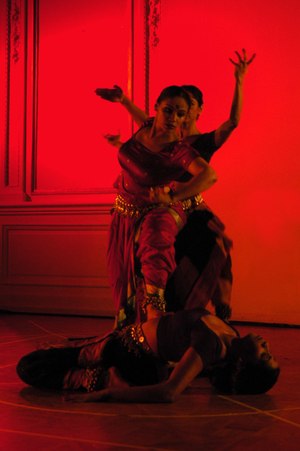MangalaCharan - Tandava
An Odissi performances normally opens with
a Mangalacharan, a classical performance which invokes the blessings
of the deity. This traditional dance began with stark lighting
and narration in English. The light brightened and the narration
faded away, leaving just dance. The dancers danced like water
flowing over a rock while also being the rock.
Faces of a Name
This work was a modern dance with Odissi
roots. It is based on the story of Chitrangada, a warrior princess.
Chitrangada falls in love with Arjuna, who has conventional ideas
about feminine beauty. Chitrangada is one of these mythic characters
with a special connection to the divine, so when she asks for
a gift of feminine virtues and beauty for a year, her wish is
granted. The dance plays with the conflict inside of Chitrangada,
as well as the conflict between her and Arjuna.
The choreography was set to modern, rhythmic
music. The choreography used both languid and rhythmic movements.
I liked the way that meaning was submerged under the abstract
dance. I thoroughly enjoyed the performance. I thought it could
be favorably paired with Oblivion.
I also think, however, that Faces of
a Name could be tightened a little. I say this because when
I observed the dance, I got the distinct impression that Chitrangada
had in the end submitted to the conflict and Arjuna's preconceptions.
The program notes indicate that the story ends by Chitrangada
demanding the right to be an equal to Arjuna and Arjuna accepting
this demand. If that is the message that Nayikas intended to convey,
and I think it is an important message to be conveyed, especially
by an all-women dance company, then they ought to survey their
audience to make sure it is getting across. If they can find an
image that sears that message into the audience, especially a
non-South Asian audience, they will have objective proof that
the choreography works as intended. (Obviously, audience research
with a South Asian audience would be important too, but the non-South
Asian audience presents the more difficult choreographic challenge
since such an audience is unlikely to know the Chitrangada story
well, and is thus unlikely to "fill in" meanings the
way a South Asian audience might.)
My other suggestion, more for fun than anything
else since the existing choreography is already quite good, is
to try to craft a dance that tells the same story, but using other
dance styles as a base. Some of the music used in Faces of
a Name was clearly conducive to Hustle. Creating an accurate
depiction of a conflicted mind is never easy, but I am sure Ms.
Mukherjee could make a substantive contribution to the science
of mental health by creating choreography that combines Odissi,
Hustle, Modern dance and Bhangra.
Pallavi - Kedar
Kaumadee
This was another classical work. There was
a faint scent of incense in the air. The dance was formal in style,
but the dancers were clearly happy to be dancing. This is exactly
what I like to see in a dance, be it an abstract or story dance.
Technique can be a framework from which the dancers can let their
emotions relax and shine forth.
Das Mahavidya
This work started with some of the dancers
dancing with lit incense. I thought it used a very appealing balance
between mime and abstraction as it presented and then elaborated
on the ten primal forms of feminine energy, known collectively
as the Das Mahavidyas in the Tantric Hindu pantheon. I also thought,
at the time, that the work presented ideas which are similar to
some of the recent convergences of physics and meta-physics at
the sub-atomic level. That's what my notes say. Unfortunately,
I can't remember exactly to what this was referring. Hopefully,
I will see this dance again and figure out what I meant. Like
dance itself, subjective linguistic transference (aka dance criticism)
is sometimes a work in progress.
Mokshya & Shloka
This final dance was energetic. There were
many spins performed on the ball of one foot with the foot raised
about a 40 degree angle from the floor. The final image of the
dancers was like a tree viewed from its base, which is appropriate
for a dance whose traditional role is to ask for peace on earth
and for all living and created things.
Tonight's performances had a consistent
high quality any South Asian New Yorker could be proud of. If
you are not South Asian and are looking for great dance and an
accessible introduction to Indian culture, Nayikas Dance Theatre
Company is an excellent group with which to journey. Nayikas was
presented as part of the MELA/South Asian Festival.
|



